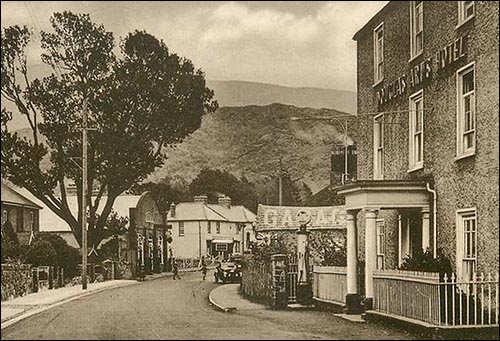The Douglas Arms, Bethesda
It’s thought this hotel was built c.1820-1830 to provide accommodation for travellers on Thomas Telford’s new London to Holyhead road (now the A5). Its four-room interior is unchanged since the 1930s. The Douglas family’s coat of arms recalls events in the 14th century and here commemorates the Douglas-Pennants who owned Penrhyn slate quarry.
 John Hughes, who’d been an Inland Revenue Officer at Bangor, took over the hotel in 1854 and advertised it as being near the “elaborate” quarries, the “Grand Pass of Nant Francon” and first-rate fishing. The hotel had “handsome spacious apartments, large airy bed-rooms” and boasted “hot, cold, and shower baths”. Visitors could borrow boats or book guides with ponies for trips into the mountains. John Hughes said Carnedd Llywelyn was “now known to be the highest mountain in Wales (see last Ordnance Survey)”!
John Hughes, who’d been an Inland Revenue Officer at Bangor, took over the hotel in 1854 and advertised it as being near the “elaborate” quarries, the “Grand Pass of Nant Francon” and first-rate fishing. The hotel had “handsome spacious apartments, large airy bed-rooms” and boasted “hot, cold, and shower baths”. Visitors could borrow boats or book guides with ponies for trips into the mountains. John Hughes said Carnedd Llywelyn was “now known to be the highest mountain in Wales (see last Ordnance Survey)”!
In 1898, a cyclist – identity unknown – crashed between Llyn Ogwen and Bethesda. He was brought to the Douglas Arms, where he died. He was buried in Glanogwen Churchyard after the people of Bethesda raised funds for a decent burial.
A Mr O’Neil and his sister stayed here in 1903 after their motor car broke down. The only way to repair it was to “wire” (send a telegram) for an “expert” to come from London!
The hotel was the local venue of choice for meetings, wedding receptions and other events, including inquests. In February 1915, Alfred Davies of the Douglas Arms provided a meat tea at the Public Hall for the Welsh Army Corps, which was passing through Bethesda on a First World War recruiting march. The group included future Home Secretary Gwilym Lloyd George (son of David Lloyd George).
The hotel has remained in the Davies family since 1913. Alfred’s son Geoffrey is still remembered for his objection to the decimalisation of British currency in 1971. Although he had to accept decimal coins and notes, for many years he continued to tell customers the price to pay in pounds, shillings and pence!
With thanks to Dr Hazel Pierce, of The History House
Postcode: LL57 3AY View Location Map

